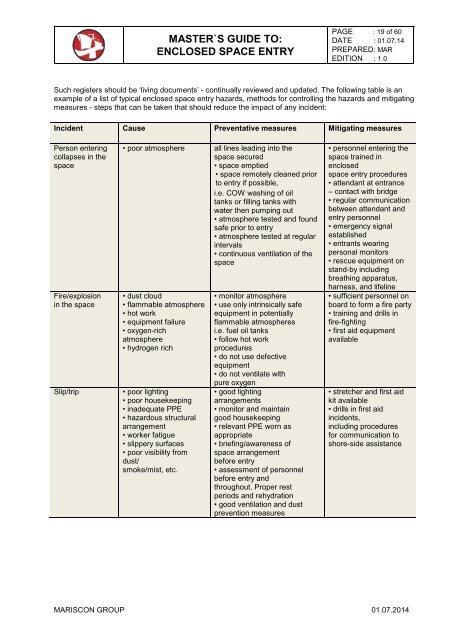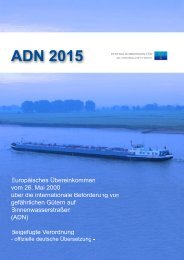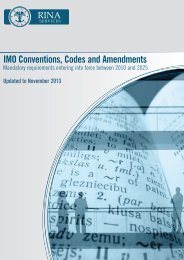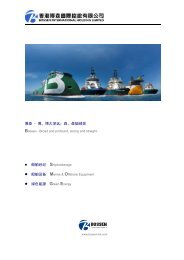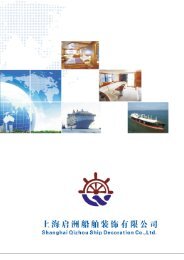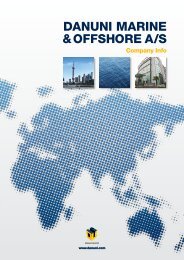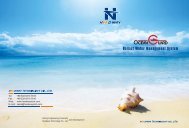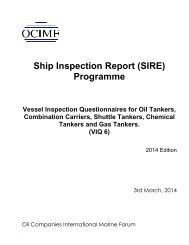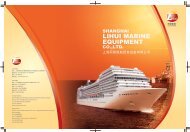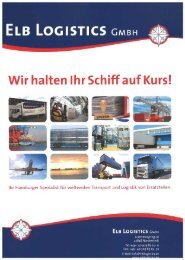MASTER`S GUIDE TO: ENCLOSED SPACE ENTRY
You also want an ePaper? Increase the reach of your titles
YUMPU automatically turns print PDFs into web optimized ePapers that Google loves.
<strong>MASTER`S</strong> <strong>GUIDE</strong> <strong>TO</strong>:<br />
<strong>ENCLOSED</strong> <strong>SPACE</strong> <strong>ENTRY</strong><br />
PAGE : 19 of 60<br />
DATE : 01.07.14<br />
PREPARED: MAR<br />
EDITION : 1.0<br />
Such registers should be ‘living documents’ - continually reviewed and updated. The following table is an<br />
example of a list of typical enclosed space entry hazards, methods for controlling the hazards and mitigating<br />
measures - steps that can be taken that should reduce the impact of any incident:<br />
Incident Cause Preventative measures Mitigating measures<br />
Person entering<br />
collapses in the<br />
space<br />
Fire/explosion<br />
in the space<br />
Slip/trip<br />
• poor atmosphere<br />
• dust cloud<br />
• flammable atmosphere<br />
• hot work<br />
• equipment failure<br />
• oxygen-rich<br />
atmosphere<br />
• hydrogen rich<br />
• poor lighting<br />
• poor housekeeping<br />
• inadequate PPE<br />
• hazardous structural<br />
arrangement<br />
• worker fatigue<br />
• slippery surfaces<br />
• poor visibility from<br />
dust/<br />
smoke/mist, etc.<br />
all lines leading into the<br />
space secured<br />
• space emptied<br />
• space remotely cleaned prior<br />
to entry if possible,<br />
i.e. COW washing of oil<br />
tanks or filling tanks with<br />
water then pumping out<br />
• atmosphere tested and found<br />
safe prior to entry<br />
• atmosphere tested at regular<br />
intervals<br />
• continuous ventilation of the<br />
space<br />
• monitor atmosphere<br />
• use only intrinsically safe<br />
equipment in potentially<br />
flammable atmospheres<br />
i.e. fuel oil tanks<br />
• follow hot work<br />
procedures<br />
• do not use defective<br />
equipment<br />
• do not ventilate with<br />
pure oxygen<br />
• good lighting<br />
arrangements<br />
• monitor and maintain<br />
good housekeeping<br />
• relevant PPE worn as<br />
appropriate<br />
• briefing/awareness of<br />
space arrangement<br />
before entry<br />
• assessment of personnel<br />
before entry and<br />
throughout. Proper rest<br />
periods and rehydration<br />
• good ventilation and dust<br />
prevention measures<br />
• personnel entering the<br />
space trained in<br />
enclosed<br />
space entry procedures<br />
• attendant at entrance<br />
– contact with bridge<br />
• regular communication<br />
between attendant and<br />
entry personnel<br />
• emergency signal<br />
established<br />
• entrants wearing<br />
personal monitors<br />
• rescue equipment on<br />
stand-by including<br />
breathing apparatus,<br />
harness, and lifeline<br />
• sufficient personnel on<br />
board to form a fire party<br />
• training and drills in<br />
fire-fighting<br />
• first aid equipment<br />
available<br />
• stretcher and first aid<br />
kit available<br />
• drills in first aid<br />
incidents,<br />
including procedures<br />
for communication to<br />
shore-side assistance<br />
MARISCON GROUP 01.07.2014


